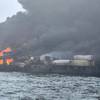LNGC Containment Market to Reach $16Bln By 2025
The global liquefied natural gas (LNG) carrier containment market was USD 11.21 billion in 2018 and is expected to reach around USD15.56 billion by 2025, growing at a CAGR of 4.9% between 2019 and 2025.
The LNG carrier containment market is majorly driven by the rising demand for natural gas from various industries and LNG’s growing number of residential and commercial applications, said a report by Zion Market Research.
Furthermore, LNG has witnessed an exponential increase in its demand as an automobile fuel in recent past, which has bolstered supportive government regulations for cleaner fuel that aims to reduce dependence on petroleum fuels.
Technological advancements that were introduced for cost-efficient and safe liquefaction of natural gas and LNG transportation have also contributed to the LNG carrier containment market. However, the volatility in prices of natural gas, the lack of supportive infrastructure for liquefaction of natural gas, and time-consuming delivery and reception of LNG in developing economies may restrain the market.
The global LNG carrier containment market is fragmented on the basis of carrier type, propulsion type, and capacity. By carrier type, the market is segmented into moss type and membrane type.
In 2018, membrane type held a major share of the global market, due to its superior capacity to bear the large pressure of LNG and its compact shape that enables it to carry large LNG volumes as compared to moss membrane.
According to propulsion type, the LNG carrier containment market includes steam turbine, ME-GI, DFDE, SSD, steam reheat, XDF, TFDE, and others.
Steam turbine segment dominated the global market, with a market share of around 40% in 2018, due to its less cost, simplified operation, and easy maintenance. On the basis of capacity, the global market comprises above 1,80,000 cubic meters, 1,50,000 to 1,80,000 cubic meters, 1,25,000 to 1,49,999 cubic meters, and 30,000 to 1,24,999 cubic meters.
In 2018, the above 1,80,000 cubic meters segment held the largest market share globally. This is due to the growing LNG demand from emerging economies of the Asia Pacific and Latin America.
The Asia Pacific region held the largest share of the LNG carrier containment market globally in 2018, due to rapid industrialization rising demand for large LNG volumes from industrialized economies of China, South Korea, and Japan, which are also the key markets for LNG at the global landscape.
North America held the second-largest share of the LNG carrier containment market globally in 2018, due to the new discoveries of natural gas reservoirs in the region. The U.S. is conventionally the key LNG supplier at the global landscape and is a crucial market for LNG carrier containments.
Europe ranked third in the LNG carrier containment market in 2018 globally, due to the regional presence of developed economies of Germany, the UK, France, and Russia, growing preference for a clean source of energy, and rising environmental awareness among the regional population.
The Middle East and Africa held a notable share of the global market for LNG carrier containment in 2018. The region historically has ample sources of natural gas and has contributed remarkably to the LNG carrier containment market globally through the LNG exports.
Latin America held the lowest share of the global market in 2018. However, the region is estimated to witness a modest CAGR in the future, owing to the growing LNG-based industries.
Major players of the LNG carrier containment market are Gaztransport & Technigaz, Mitsui O.S.K Lines, Teekay LNG Partners, NYK Line, Gaslog, MISC Berhad, Dynagas LNG Partners, BW Gas, Samsung Heavy Industries, Hudong-Zhonghua Shipbuilding, and Kawasaki Heavy Industries.








